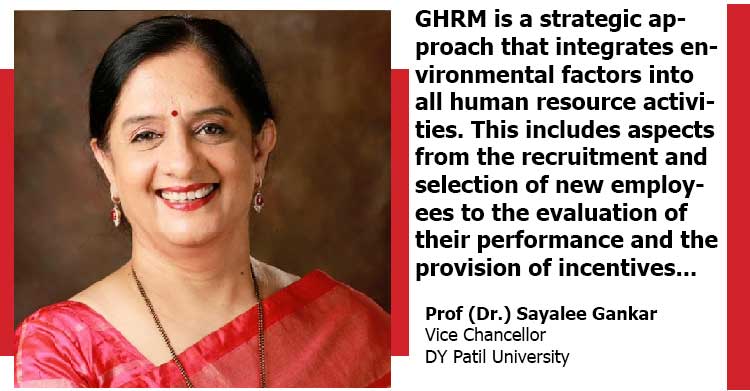Harmony in the Workplace: Achieving Sustainability through Green Human Resource Management (GHRM) | Prof (Dr.) Sayalee Gankar | Vice Chancellor | DY Patil University

The global community is currently grappling with unprecedented ecological challenges, prompting corporations to increasingly operate in a more environmentally responsible manner. However, the focus extends beyond technology and infrastructure, as a crucial element lies at the heart of every organization: its people. Green Human Resource Management (GHRM) emerges as the solution to this issue.
GHRM is a strategic approach that integrates environmental factors into all human resource activities. This includes aspects from the recruitment and selection of new employees to the evaluation of their performance and the provision of incentives. The objective is to cultivate a culture of environmental consciousness and accountability among employees, ultimately resulting in a more sustainable firm.
GHRM practices contribute to environmental sustainability through fundamental methods:
Green Recruitment and Selection: Attracting individuals committed to environmental sustainability, evaluating candidates’ environmental knowledge, using eco-friendly interview techniques, and emphasizing the company’s environmentally conscious initiatives in job advertisements.
Green Training and Development: Equipping employees with information and abilities for environmentally conscious job responsibilities, including instruction on energy preservation, waste minimization, and sustainable methodologies.
Green Performance Management and Appraisal: Assessing employees’ environmental performance, encouraging sustainable activities, and holding employees accountable for their environmental footprint.
Green Incentives and Remuneration: Acknowledging and compensating employees advocating for environmental sustainability with incentives such as monetary rewards, leave, or alternative forms of acknowledgment.
Enhancing Employee Involvement and Communication: Establishing a culture empowering employees to actively participate in achieving the company’s environmental objectives, involving transparent communication, avenues for input, and empowering employees to spearhead environmentally conscious activities.
Adopting GHRM methods goes beyond environmental sustainability, positively impacting employee morale, engagement, and productivity, while also enhancing a company’s reputation and attracting clientele and investors prioritizing environmental sustainability.
To integrate GHRM into your business, follow these steps:
Perform an Environmental Audit: Identify areas for enhancing environmental performance.
Create an Environmentally Sustainable HR Policy: Clearly state dedication to GHRM and precise strategies.
Provide Training to HR Team: Ensure the HR team is well-versed in GHRM principles and practices.
Communicate Environmentally Friendly Initiatives: Share your dedication to sustainability with staff and provide information on active participation.
By adopting sustainable HR practices, organizations can demonstrate a commitment to meaningful change. An environmentally friendly workplace benefits not only the environment but also the profitability and sustainability of the organization. Ultimately, a dedication to sustainability aligns with wider objectives of economic sustainability and environmental accountability, contributing to the overall prosperity and durability of the organization.


